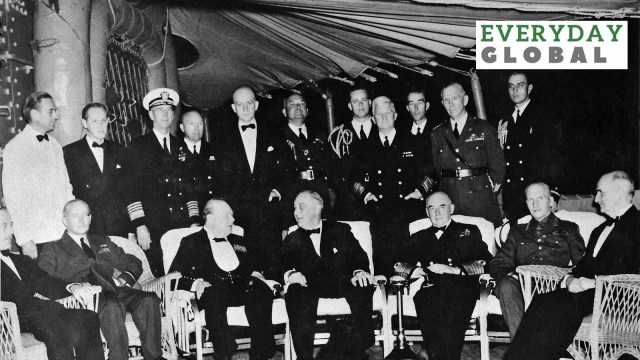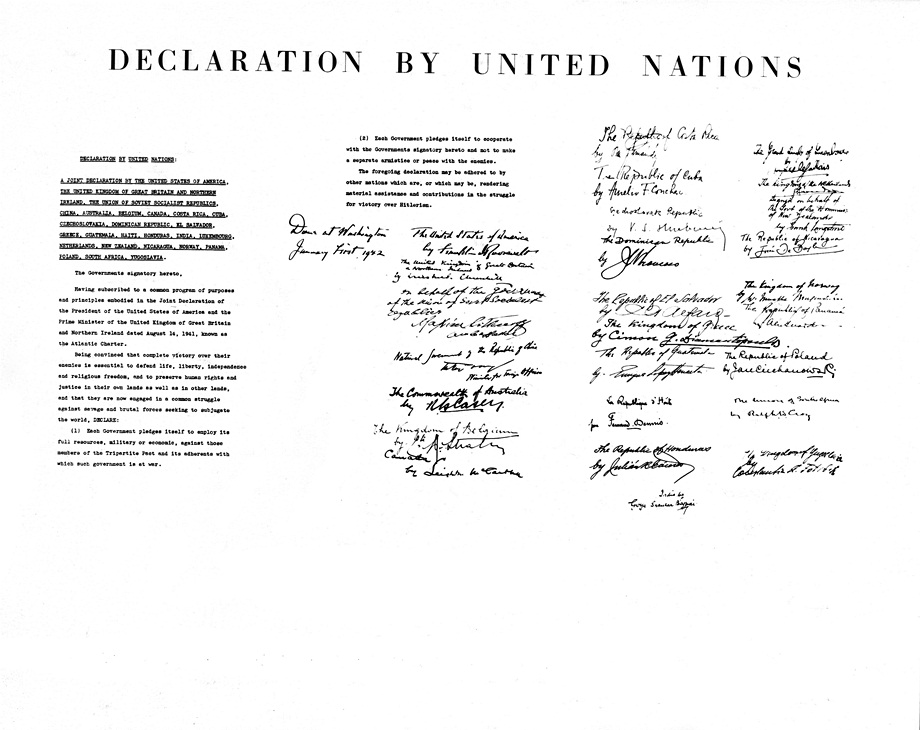How the United Nations was born on this day in 1945, and how it has evolved
Why was the UN established, and how far has it succeeded in fulfilling its mandate? How has its role changed in modern times? We explain.
 President Roosevelt & Prime Minister Churchill on the U.S.S. Augusta in a formal evening gathering. They would later lay down the founding principles of the UN, under the Atlantic Charter. (Photo via UN)
President Roosevelt & Prime Minister Churchill on the U.S.S. Augusta in a formal evening gathering. They would later lay down the founding principles of the UN, under the Atlantic Charter. (Photo via UN) In 1945, on this day, the United Nations was founded amid a period of turmoil in international relations. The Second World War (1939-45) had just ended, coming a few years after the devastation caused by the First World War (1914-18).
Countries that had dominated world affairs had suffered a great deal after the two wars, and there were two emerging new powers, in the form of the United States and the USSR, who looked set to rival each other. Born out of the horrors of that period, the UN was primarily tasked with the goal of maintaining world peace and saving future generations from the evils of war.
Here is the story of its inception, and how its role has evolved in the decades since.
The birth of the United Nations
The UN was born out of the ashes of yet another international organisation created with the intention of keeping war away. The League of Nations was created in June 1919, after World War I, as part of the Treaty of Versailles. However, when the Second World War broke out in 1939, the League closed down and its headquarters in Geneva remained empty throughout the war.
Consequently, in August 1941, American President Franklin D. Roosevelt and British Prime Minister Winston Churchill held a secret meeting aboard naval ships in Placenta Bay, located on the southeast coast of Newfoundland, Canada. The heads of the two countries discussed the possibility of creating a body for international peace efforts and a range of issues related to the war.
Together they issued a statement that came to be called the Atlantic Charter. It was not a treaty, but only an affirmation that paved the way for the creation of the UN. It declared the realisation of “certain common principles in the national policies of their respective countries on which they based their hopes for a better future for the world.”
The United States joined the war in December 1941, and for the first time the term ‘United Nations’ was coined by President Roosevelt to identify those countries which were allied against the axis powers – Germany, Italy and Japan. On January 1, 1942, representatives of 26 allied nations met in Washington DC to sign the declaration of the United Nations, which basically spelt out the war objectives of the Allied powers.
India, which was under British colonial rule at the time, was also among these nations. According to a Ministry of External Affairs release, “Independent India viewed its membership at the United Nations as an important guarantee for maintaining international peace and security.”
 Declaration by the UN pledging “to employ its full resources, military or economic” in “the struggle for victory over Hitlerism”. This document contained the first official use of the term “United Nations”, which was suggested by US President Roosevelt. (Via United Nations)
Declaration by the UN pledging “to employ its full resources, military or economic” in “the struggle for victory over Hitlerism”. This document contained the first official use of the term “United Nations”, which was suggested by US President Roosevelt. (Via United Nations)
Over the next couple of years, several meetings took place among the Allied Big Four — the United States of America, the Soviet Union, the United Kingdom and China — to decide on the post-war charter that would describe the precise role of the United Nations.
The United Nations finally came into existence on October 24, 1945, after being ratified by 51 nations, which included five permanent members (France, the Republic of China, the Soviet Union, the UK and the US) and 46 other signatories. The first meeting of the General Assembly took place on January 10, 1946.
The four main goals of the UN included maintaining international peace and security, developing friendly relations among nations, achieving international cooperation in solving international problems and being at the center for harmonising the actions of nations in the attainment of these common ends.
Achievements and failures of the UN
While at the time of its formation, the UN consisted of only 51 member states, independence movements and de-colonisation in the subsequent years led to an expansion of its membership. At present, 193 countries are members of the UN.
The UN boasts of several significant achievements in the last 75 years. It has also expanded its scope to cover a large number of global issues such as health, environment, women empowerment, among others.
Soon after its formation, it passed a resolution to commit to the elimination of nuclear weapons in 1946. In 1948, it created the World Health Organisation (WHO) to deal with communicable diseases like smallpox, malaria, HIV. At present the WHO is the apex organisation dealing with the coronavirus pandemic.
In 1950, the UN created the High Commissioner for Refugees to take care of the millions who had been displaced due to World War II. It continues to be on the frontlines of crises faced by refugees from countries across the world. In 1972, the UN environment programme was created. More recently in 2002, the UN established the UN criminal court to try those who have committed war crimes, genocide, and other atrocities.
The UN has also met with its share of criticisms. In 1994, for instance, the organisation failed to stop the Rwandan genocide. In 2005, UN peacekeeping missions were accused of sexual misconduct in the Republic of Congo, and similar allegations have also come from Cambodia and Haiti. In 2011, the UN peacekeeping mission in South Sudan was unsuccessful in eliminating the bloodshed caused by the civil war that broke out in 2013.
On a more fundamental level, its structure and other organisations associated with it, such as the World Bank and the IMF, have been criticised for furthering neo-liberal ideas – related to championing free markets and a reduced role of governments. This has been linked to deepening inequalities within countries. Further, the UN has been seen as unrepresentative of its members, particularly countries in the Global South.
At a high-level meeting of the UN General Assembly in 2020, commemorating 75 years of the UN, a declaration was adopted that also set out its goals for the next decade.
“The next 10 years, which have been designated as the decade of action and delivery for sustainable development, will be the most critical of our generation. It is even more important as we build back better from the COVID-19 pandemic,” read the report. The goals included protection of the planet and environment, promoting peace, gender equality and women empowerment, digital cooperation, and sustainable financing.
This is an updated version of an explainer first published in 2020, you can click here to read it.
- 01
- 02
- 03
- 04
- 05






































